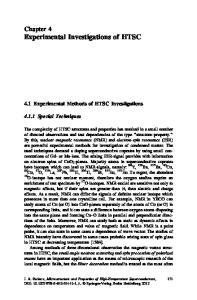Techniques for Structural Investigations (Theory and Experimental)
In order to investigate the structure and electronic behavior of chalcogenide materials, commonly used techniques include XRD (X-ray diffraction), SEM (scanning electron microscopy), and XAFS (X-ray absorption fine structure). XRD can determine the crysta
- PDF / 5,943,130 Bytes
- 44 Pages / 439.37 x 666.142 pts Page_size
- 58 Downloads / 335 Views
Techniques for Structural Investigations (Theory and Experimental) Yun Mui Yiu
Canadian Light Source (CLS), Synchrotron facility at University of Saskatchewan, Saskatoon, Canada Picture: Courtesy: Canadian Light Source Inc.
This chapter reviews some of the techniques widely used for characterization of structure and properties of materials. Y.M. Yiu, Ph.D. (*) Chemistry Department, University of Western Ontario, 1151 Richmond Street, London, N6A5B7, ON, Canada e-mail: [email protected] © Springer International Publishing Switzerland 2017 G.K. Ahluwalia (ed.), Applications of Chalcogenides: S, Se, and Te, DOI 10.1007/978-3-319-41190-3_2
61
62
2.1
Y.M. Yiu
Introduction
The theory described in this section concerns mainly the X-ray determination of the chalcogenide substances. Surface second harmonic generation using laser is also presented. To characterize a material in microscale to nanoscale, SEM (scanning electron microscopy) and TEM (transmission electron microscopy) are useful laboratory tools. Together with XRD, it can assist with the determination of crystalline states and further determine space group symmetry of the materials under investigation for DFT (density functional theory) calculations. The cluster form of matters with a small scale of order can be investigated by the second program, RSMS (Real Space Multiple Scattering). The RSMS program provides an analysis to the nanoscale properties of materials.
2.1.1
Density Functional Theory (DFT)
Density functional theory (valid for all types of materials) proposes that the electronic charge density, n(r), completely determines all features of the electronic behavior of a system of interacting electrons in the ground state. Energy of the interacting electronic gas is a unique functional (function of a function) of the charge density [1]. Although the functional is not known, the Hohenberg–Kohn theorem allows a variational principle to be established to find the ground state energy: the energy functional takes its minimum value (i.e., the ground state energy) when the charge density n(r), is the true ground state charge density. Nobel Prize winners, P. Hohenberg and W. Kohn, first introduced the density functional theory [1]. It has been developed using the concept of inversely mapping a “measurable” quantity, the electron density, into Eigen-function in Hilbert space. The recent novel approach highlighted the many-body problem by introducing the exchange-correlation function. DFT program can thus solve the differential equation by the local density approximation (LDA). Generalized gradient approximation (GGA) is later introduced. It assures a first energy derivative correction to the total energy of the system. The calculations then enter into a self-consistent iteration by minimizing the energy to tune into the equilibrium state of the physical system. From a theoretical point of view, the complexity of materials creates a big task for modern computation facilities. The numerical calculation is costly and CPU time demanding for materials possessing com
Data Loading...











